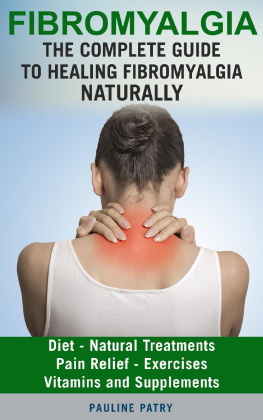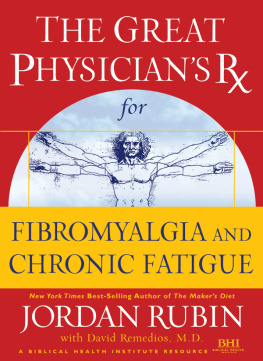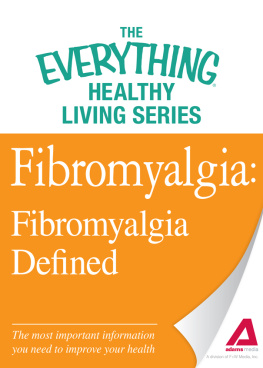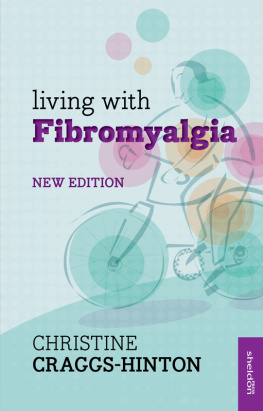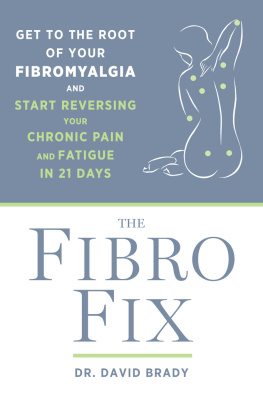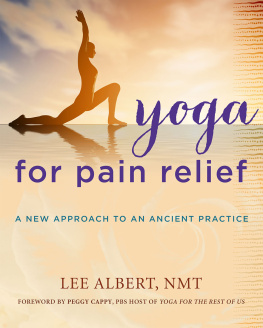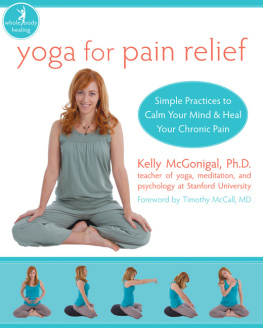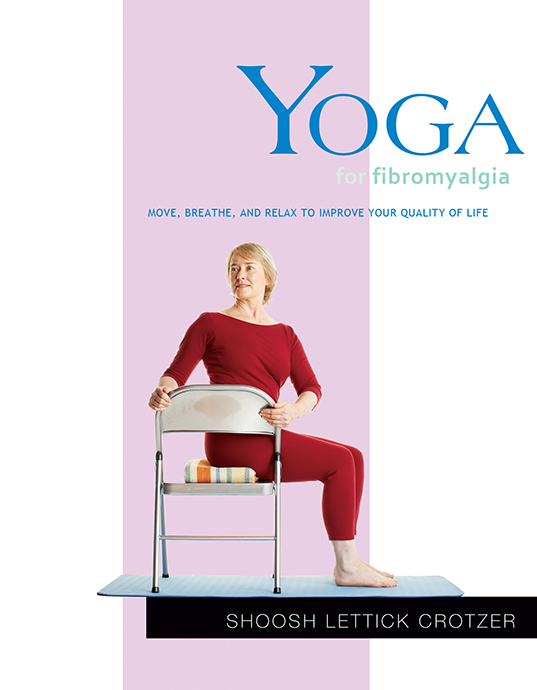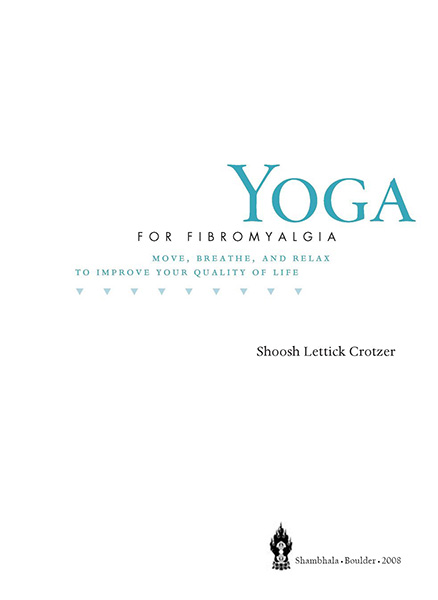Table of Contents
Praise forYoga for Fibromyalgia
Shoosh Lettick Crotzer has written a wonderful guide for women with fibromyalgia. It is not only clear that she understands the health issues of patients, but also clear that she understands the benefits of empowering women to take charge of their health. I love the emphasis on how to apply principles of yoga to everyday life. This book is packed with practical advice and I will recommend it to my patients.
Leslie J. Crofford, M.D., Univeristy of Kentucky; Gloria W. Singletary Professor; Chief, Division of Rheumatology and Womens Health; Director, Center for the Advancement of Womens Health
Shoosh is a healer. She shares techniques and gifted insights honed and focused for a lifetime. In Yoga for Fibromyalgia, she gives practical ways to relieve pain, improve mobility, and restore health. Share it with a loved one in need.
Ganga White, author of Yoga Beyond Belief: Insights to Awaken and Deepen Your Practice
This book offers clear and relevant yoga and lifestyle information to those suffering from fibromyalgia. But it offers something even more important: hope that things can get better. Highly recommended for yoga teachers, for experienced yoga students, and for those people just beginning to practice.
Judith Hanson Lasater, Ph.D., P.T., author of 30 Essential Yoga Poses: For Beginning Students and Their Teachers
Shoosh Lettick Crotzer understands that most people with fibromyalgia can benefit from a gentle approach to yoga. In this book, she teaches a variety of helpful poses and visualization techniques; suggests practice routines to meet your changing needs; and, most important for healing, guides you toward making yoga part of your everyday life.
Timothy McCall, M.D., medical editor of Yoga Journal; author of Yoga as Medicine: The Yogic Prescription for Health and Healing
This book is an inviting introduction to yoga for fibromyalgia sufferers. With a well-considered series of gentle stretches and breathing and relaxation exercises, this program is beneficial even for more debilitated beginners and forms a foundation for those students ready to move on to other active yoga poses.
Julie Gudmestad, P.T., director, Gudmestad Yoga Studio, Portland, Oregon; author of Yoga Journals Anatomy column
Ms. Crotzers breathing and awareness techniques are excellent for increasing focus and mental clarity, which facilitate coping not only with fibromyalgia but also with general stress. She has done a terrific job of adapting traditional yoga poses, some of which can be done in a chair. And the books instructions and photos make the poses easy to follow. I particularly like the sections called Everyday Yoga (at the end of each pose), which give examples of how to use the poses throughout the day. Her yoga sequences can clearly help people with fibromyalgia in a way that is gentle and does not cause pain.
Jeanne Melvin, M.S., OTR/L, FAOTA, author of Fibromyalgia Syndrome, Getting Healthy; in practice at Solutions for Wellness, Santa Monica, CA
For Bonnie, who has spent many years coping with fibromyalgia. I hope this book helps provide some relief for you and many others.
Acknowledgments
I began practicing yoga in 1974 with my first teacher, Sambhu, and I maintain a thankful place in my heart for his gift to me. Through him I met Ganga White, who has become a friend as well as a teacher. I take students to his White Lotus Foundation annually for a private class and discussion with him and his wonderful partner and wife, Tracey Rich. They remain models for me of blending the practice of yoga with the art of living yoga.
In 1976 I studied in Ann Arbor, Michigan, with some of B. K. S. Iyengars devoted students, who were responsible for bringing him and his yoga to the United States. From them, I learned the foundation of my own yoga. Mr. Iyengars contributions to yoga are invaluable.
One of my most influential teachers does not teach yoga. I call Dr. John Hannon the Zen master of body workers. He taught me new ways to understand my own body and then guided me to keep making new discoveries. This changed my yoga practice and the way I teach yoga in an unexpected and exciting manner. Not a day goes by that I dont thank him. John also gave me valuable pointers in reviewing the early drafts of this book, for which I am grateful.
Donna Everix also reviewed this book. Her knowledge as a physical therapist specializing in arthritis and fibromyalgia has been a guiding light for me since we worked together on Yoga for Arthritis. She was the Arthritis Foundations consultant on that project, and we have been friends and colleagues since.
Dr. Barry Dorfman, a psychiatrist, along with his wife, Leabah Winter, who has fibromyalgia, also were instrumental in helping me fine-tune this book. We spent many hours discussing and rewriting, and I am sincerely indebted to them for their help.
Joni Hunt, yoga student, editor, and friend, graciously helped me with her editing skills. I owe her many thanks.
My brother David Lettick, an artist and writer, reviewed the first draft in great detail, offering me insights and useful edits. I am lucky to have a close-knit and supportive family, including my husband, Colby. I thank them for their advice, encouragement, and love.
I thank Donald Moyer and Linda Cogozzo for inspiring me to write this book. Their educated and patient assistance helped create this final edition.
Most important of all, I thank my students for teaching me what they need.
Foreword
In Yoga for Fibromyalgia, Shoosh Lettick Crotzer has skillfully adapted the traditional practice of yoga asana (poses) to the needs of those with the painful, chronic condition of fibromyalgia. It is a condition I know well, and I was pleased to serve as the model for the poses in the book.
When I experienced my first symptoms of fibromyalgia, about eighteen years ago, I was a yoga teacher and a professional dancer. Even though I had been giving private yoga sessions to students with chronic fatigue syndrome, which some consider to be related to or the same as fibromyalgia, I did not at that time recognize what the sudden onset of fatigue, pain, dizziness, and a host of other symptoms meant for me. Nor did my doctor.
Over the next fifteen years, the symptoms came and went, triggered by encounters with various stressors. I learned that this particular constellation of symptoms was indicative of fibromyalgia, and that there was, at that time, no definitive treatment for it. I continued to practice and teach yoga in accord with my pain and energy levels. When I was ill, my practice emphasized rest in supported and basic supine postures, which gently eased the painfully tight muscles, decreased inflammation, and restored deep sleep. When I was well, a more active practice rebalanced and strengthened the affected muscle groups and realigned my posture. I lived an almost normal life.
I believe Shooshs presentation of yoga poses, specifically adapted for fibromyalgia, can help those who also have this painful condition find ease, balance, rest, and hope. I encourage those who teach yoga to people with fibromyalgia to study and consider incorporating Shooshs approach into their teaching practice, and I strongly recommend



